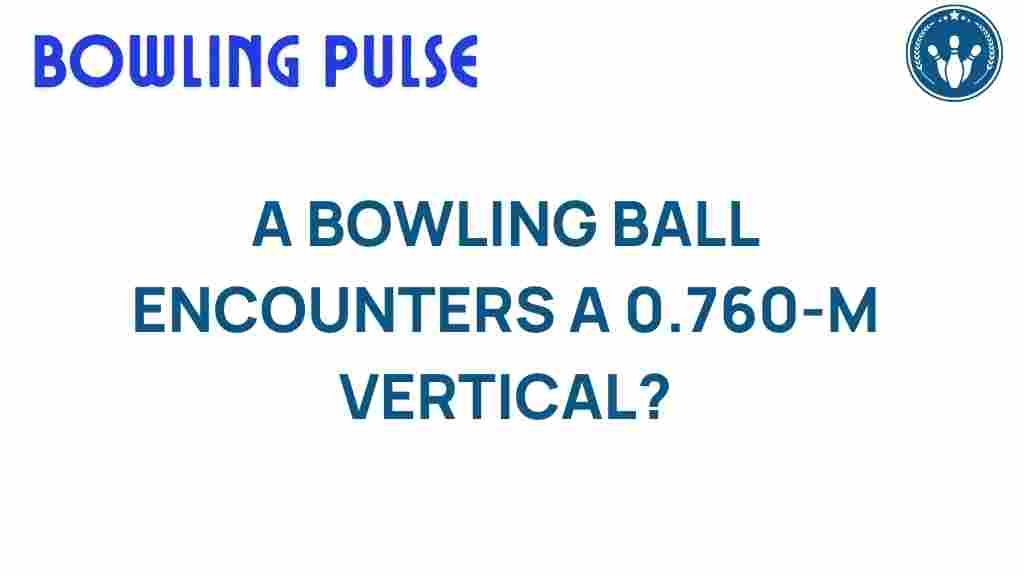What Happens When a Bowling Ball Faces a 0.760-M Vertical Drop?
Have you ever wondered what would happen if a bowling ball were to fall from a significant height? In this article, we will explore the effects of a 0.760-meter vertical drop on a bowling ball, analyzing the physics behind the impact, the forces involved, and the dynamics of sports science. Understanding these concepts can enhance our grasp of mechanics in sports and provide valuable insights into experiments involving gravity and impact force.
The Basics of Physics and Gravity
Before diving into the specifics of a bowling ball’s drop, it’s essential to understand some basic principles of physics and gravity. Gravity is the force that attracts two bodies towards each other, and on Earth, it gives weight to physical objects. The standard acceleration due to gravity is approximately 9.81 m/s².
When an object falls freely under the influence of gravity, it accelerates at this constant rate. The distance fallen can be calculated using the formula:
- d = 0.5 * g * t²
Where:
- d = distance (in meters)
- g = acceleration due to gravity (9.81 m/s²)
- t = time (in seconds)
The Mechanics of a Bowling Ball Drop
When a bowling ball is dropped from a height of 0.760 meters, it experiences the following:
- Free Fall: The bowling ball will accelerate downwards at 9.81 m/s² until it reaches the ground.
- Impact Force: Upon hitting the ground, the ball experiences a force that can be calculated using Newton’s second law of motion.
- Deformation: Depending on the surface it impacts, the bowling ball may deform slightly, affecting the impact force experienced during the collision.
Calculating the Impact Force
To understand the implications of a bowling ball facing a vertical drop, we need to calculate the impact force when it hits the ground. The impact force can be determined using the formula:
- F = m * a
Where:
- F = impact force (in Newtons)
- m = mass of the bowling ball (approximately 6 kg for a standard bowling ball)
- a = deceleration during impact (which can be very high depending on the time to come to rest)
To simplify the calculation, let’s assume the bowling ball comes to a stop almost instantaneously upon impact. The force of impact can also be approximated by considering the change in momentum:
- F = Δp / Δt
Where:
- Δp = change in momentum
- Δt = time duration of the impact (which is very short, typically in milliseconds)
Understanding the Dynamics of Sports Science
The dynamics of the bowling ball’s drop also relate to various aspects of sports science. When analyzing sports dynamics, it is crucial to consider how different variables interact:
- Surface Impact: The type of surface the bowling ball hits (e.g., wood, carpet, concrete) significantly influences the impact force.
- Material Properties: The composition of the bowling ball affects how it deforms and absorbs energy during impact.
- Angle of Impact: Although this analysis focuses on a vertical drop, the angle can change the distribution of force upon impact.
Step-by-Step Process of an Experiment
If you want to conduct an experiment to observe what happens when a bowling ball faces a 0.760-meter vertical drop, follow these steps:
- Gather Materials:
- Standard bowling ball (6 kg)
- Measuring tape
- Impact force sensor (optional, for accurate measurements)
- Safety gear (e.g., goggles)
- Notebook for recording observations
- Measure the Drop Height: Use the measuring tape to ensure the drop height is exactly 0.760 m.
- Prepare the Drop Zone: Choose a safe location for the drop, ensuring no one is in the vicinity to avoid injury.
- Drop the Bowling Ball: Release the ball from the measured height without applying any initial force.
- Observe and Record: If using an impact force sensor, record the peak impact force. Otherwise, note any visible changes to the ball or the impact surface.
Troubleshooting Tips
While conducting your experiment, you may encounter some challenges. Here are some troubleshooting tips:
- Inaccurate Drop Height: Ensure that your measuring tape is correctly positioned and that you are dropping from the exact height.
- Unstable Surface: Make sure the surface you are dropping onto is stable and does not shift during the impact.
- Using a Sensor: If using an impact force sensor, ensure it is calibrated correctly before the experiment.
Possible Results and Analysis
After conducting the experiment, analyze the results. Here are some possible outcomes:
- No Visible Damage: If the ball shows no signs of damage, it indicates high durability and energy absorption.
- Surface Marks: If the surface shows marks, it suggests that energy was transferred upon impact.
- Measured Impact Force: If you measured impact force, compare it to theoretical calculations to assess accuracy.
These results can lead to further discussions about the mechanics involved in sports and how different variables affect outcomes.
Conclusion
In conclusion, a bowling ball facing a 0.760-meter vertical drop provides an excellent opportunity to study the principles of physics, sports dynamics, and mechanics. By understanding the forces at play and conducting experiments, we can gain valuable insights into the impact of gravity and the behavior of objects in motion.
This knowledge is not only applicable to bowling but can also enhance our understanding of various sports and their dynamics. For more in-depth information about sports science and mechanics, consider checking out Sports Science Resources.
Whether you are a student, a coach, or simply a sports enthusiast, experimenting with concepts like these can deepen your appreciation for the intricate relationship between physics and sports.
This article is in the category Techniques and created by BowlingPulse Team
